The 6.8 Western is being loaded by Browning and Winchester and is being touted as the ultimate big-game hunting cartridge. John Whipple
If you want to introduce a successful new big-game cartridge these days, it’s got to be the fastest, hottest, hardest-hitting, new load ever created, right? Well, actually, no. Browning and Winchester’s 6.8 Western rifle cartridge works off the concept that if you take a long, sleek, heavy bullet and fire it at a reasonable velocity, you’ll get just as good down-range performance as ultra-fast bullets that are less streamlined. And, you’ll get that performance with less recoil.
So their engineers took a look at the .270 Winchester Short Mag., which came out in 2002, before the trend of longer, more aerodynamic bullets took off. They lowered the case shoulder to allow for a longer bullet in a short-action rifle. That also meant less propellant loaded into the round.
“The challenge in 6.8 Western was all about balance,” says Kyle Masinelli, director of New Product Development for Olin Winchester. “It was the balance of taking a parent case in .270 WSM and actually taking away powder capacity to make it more powerful down range. It seems counterintuitive, but that was exactly what was accomplished. If we compare it to our top performing 270 WSM cartridge, the 6.8 Western has 10 percent less propellant, but has 12 percent more energy at 500 yards. It seems that we cheated physics somewhat, but we really just used it to our advantage by optimizing case capacity and bullet weight. Less propellant also equates to less muzzle blast.”
It’s also notable that the rifles chambered for this cartridge have faster twist rifling than the old .270, using either 1:8 or 1:7.5 twist.
Browning and Winchester are touting this cartridge as a long-range hunting and target shooting load, likely to try to capture some of the excitement created by the 6.5 Creedmoor and 6.5 PRC, and solve for some of the criticism (albeit misplaced) that those cartridges don’t offer heavy enough bullets for taking down larger game like elk or moose. With the 6.8 Western’s heavier bullets, Winchester says it’s bringing 16 percent more energy than the 6.5 PRC at 500 yards and 67 percent more energy than the 6.5 Creedmoor. And the 6.8 Western can take on some of the big boomers at long range as well. In fact, Browning’s 175-grain Long Range Pro load has more energy at 500 yards and beyond than most 180-grain factory loads in .300 Win. Mag.
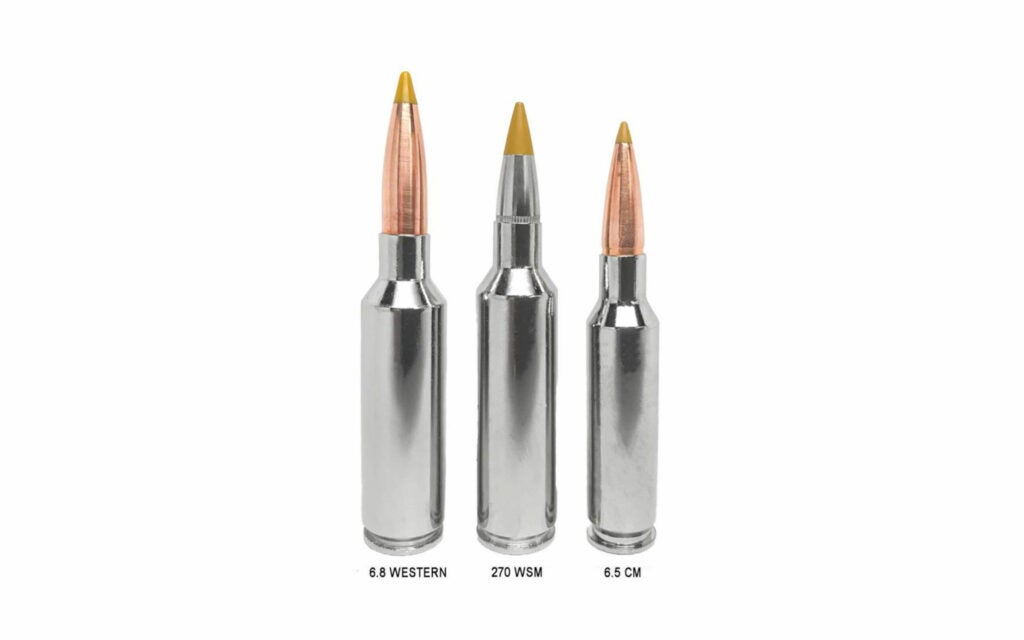
The 6.8 Western (left) compared to the .270 WSM and 6.5 Creedmoor. Browning
Winchester is claiming 24 ft-lb of recoil in an 8-pound rifle, which is about the same as a 7mm Rem. Mag., which is its true ballistic competitor (based on bullet weights, diameter, and muzzle velocity).
6.8 Western Ammo and Ballistics
When it was first introduced in 2021, there were two bullet options, the 165-grain Accubond Long Range and the 175-grain Sierra Tipped Game King. Now, there are a few more options, but Winchester and Browning are still the only ones loading it. Factory 6.8 Western factory ammo options include:
- Winchester Copper Impact, 162 grains
- Winchester Ballistic Silvertip, 170 grains
- Winchester Power Point, 170 grains
- Winchester Match BTHP, 170 grains
- Winchester Accubond Long Range, 165 grains
- Browning Sierra Tipped Game King, 175 grains
Below you can see the ballistic tables for the Sierra Tipped Game King and Accubond Long Range loads.
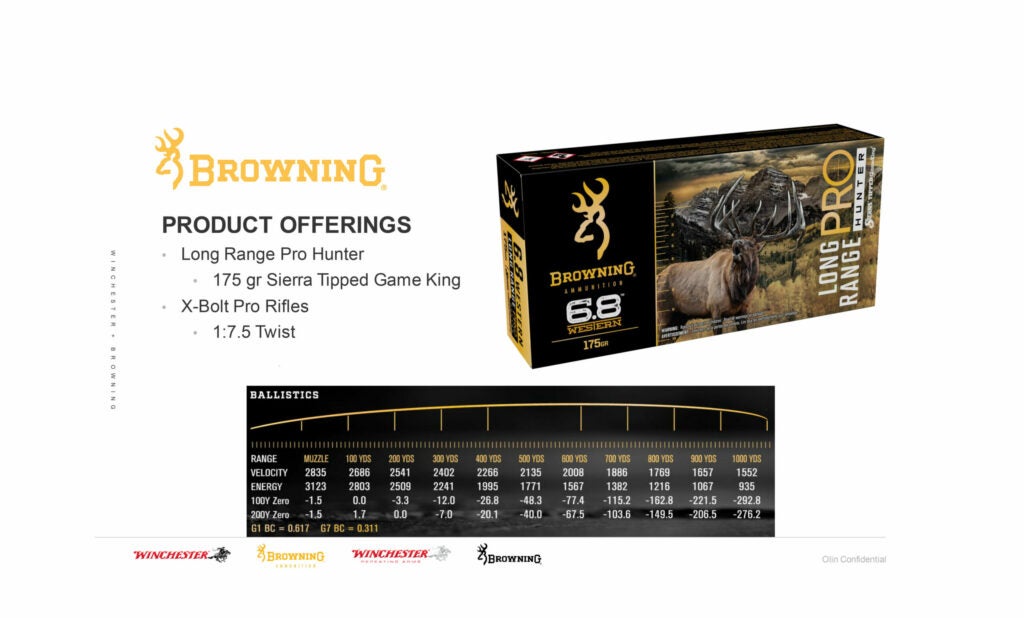
Ballistic table for the 6.8 Western in 175-grain Sierra Tipped Game King bullets. Browning
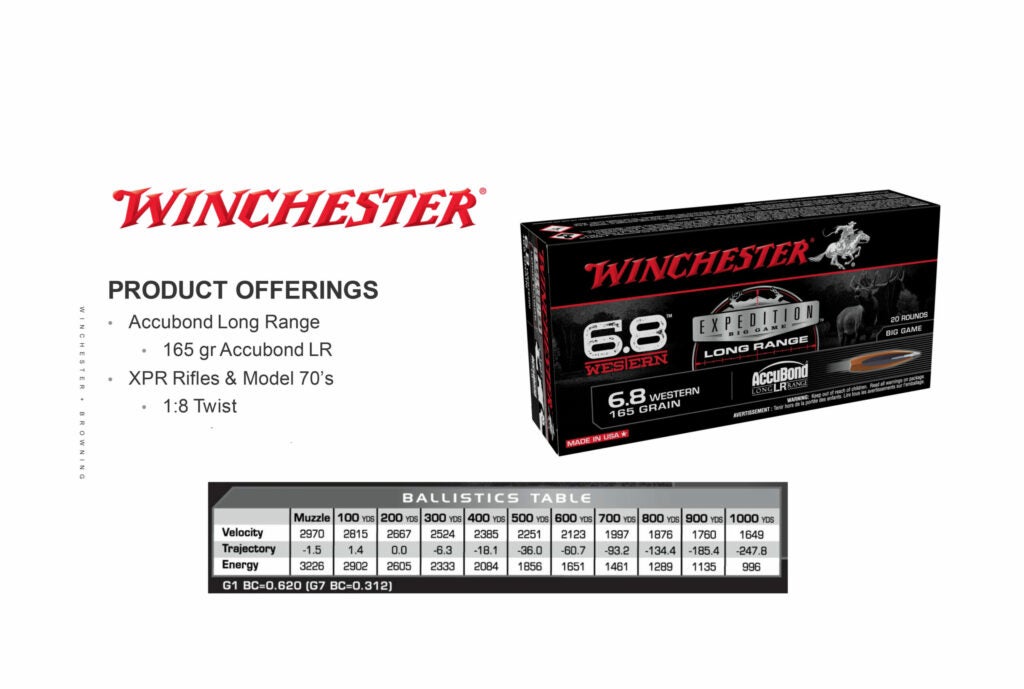
The ballistics table for the 6.8 Western in 165-grain Accubond Long Range. Winchester
6.8 Western Accuracy
A key to making a successful long-range hunting cartridge is accuracy. Without that, all else is null and void. Fortunately for the 6.8 Western, it delivers. We’ve done accuracy testing with two different Browning rifles chambered in 6.8 Western—the lightweight X-Bolt Mountain Pro, and the heavier-barreled X-Bolt Western Hunter. We used a five-shot-group accuracy protocol for each rifle, using a minimum of five groups total for an accuracy aggregate.
Freel used the X-Bolt Mountain Pro on an aoudad hunt in the border mountains of Texas and also did accuracy testing at ten below zero in Alaska. The light-barreled Mountain Pro averaged 1.18-inch groups with the Browning 175-grain Tipped SGK load and 1.27-inches with Winchester’s 165-grain Nosler ABLR load.
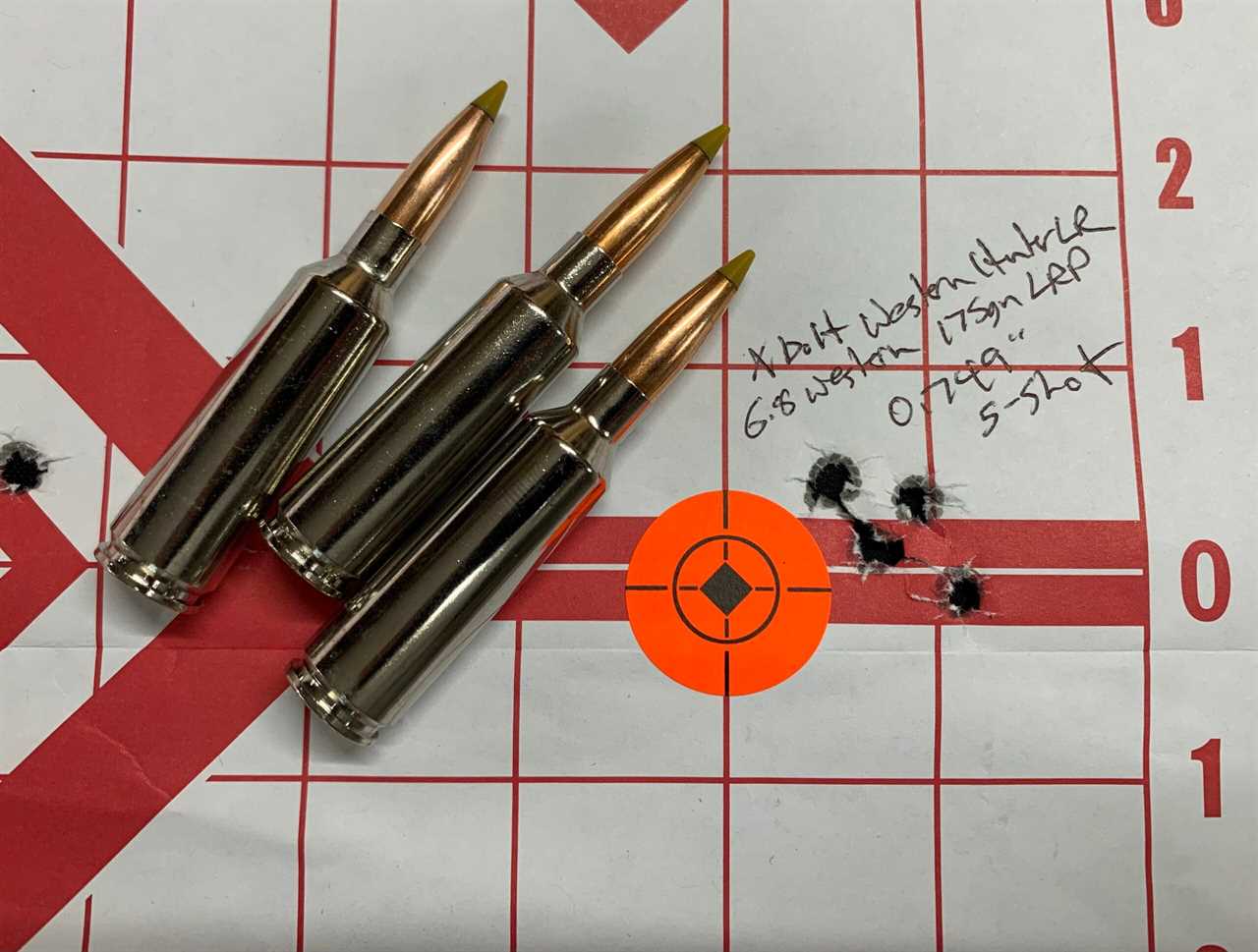
The X-Bolt Western Hunter LR printed consistent groups with Browning’s Long Range Pro Hunter load, shooting 175 grain Sierra Tipped Game King bullets.
We also tested the X-Bolt Western Hunter thoroughly, recording 20 groups as part of a test of mid-priced hunting rifles. The top 50 percent of recorded groups averaged .93 inches, and the overall average group size for those 20 groups was 1.28 inches. The Browning 175-grain Sierra TGK load averaged 1.21 inches overall but displayed a tight standard deviation in group size.
For five-shot groups out of hunting-weight rifles, these results are good, and we believe the accuracy potential of the cartridge is even greater—if more manufacturers get in the game or hand loaders tweak it to their liking.
Has the 6.8 Western Succeeded?
A little more than a year after its introduction, Browning has 18 rifle variations chambered in 6.8 Western and Winchester has more than a dozen on top of that. So clearly, both companies are working hard to support the new cartridge. But the 6.8 Western hasn’t replaced veteran cartridges like the 7mm Rem. Mag. or the .270 WSM just yet.
“The 6.8 Western is definitely one of our fastest growing in regard to cartridge sales, but with a new cartridge like this it takes several years to get enough firearms produced to meet demand,” says Nathan Robinson, marketing manager for Winchester Ammunition. “Having just announced the 6.8 Western in 2021, we are very much still within the growth period for this cartridge, yet demand has exceeded our expectations and we would be selling much more if we could make more firearms faster.”
Also, it’s a challenging time to introduce new hunting cartridge. Ammo availability has been scarce for years and many shooters are more interested in getting ammo for guns they already own than they are with experimenting with a new rifle and cartridge. Finding ammo on shelves has also been a challenge for all but a handful of hunting loads. A quick online search showed that many online retailers were still out of stock on 6.8 Western ammo.
“Due to the recent growth in hunting participation and overall ammunition demand, availability has been spotty for most types of ammunition for the last two years or so,” Robinson says. “While the 6.8 Western is no exception, Winchester is committed to supporting this new cartridge and has been producing a sizable amount to ensure that those who have acquired new guns chambered in 6.8 Western will be able to use it for upcoming hunting seasons.”
Field Testing the 6.8 Western
Since the 6.8 Western has been introduced, we’ve be able to shoot a variety of different loads on hunts all over the country. We’ve taken several big game animals with it. Here’s an overview of field performance with the different loads and rifles.
175-Grain Sierra Tipped Game King in 6.8 Western
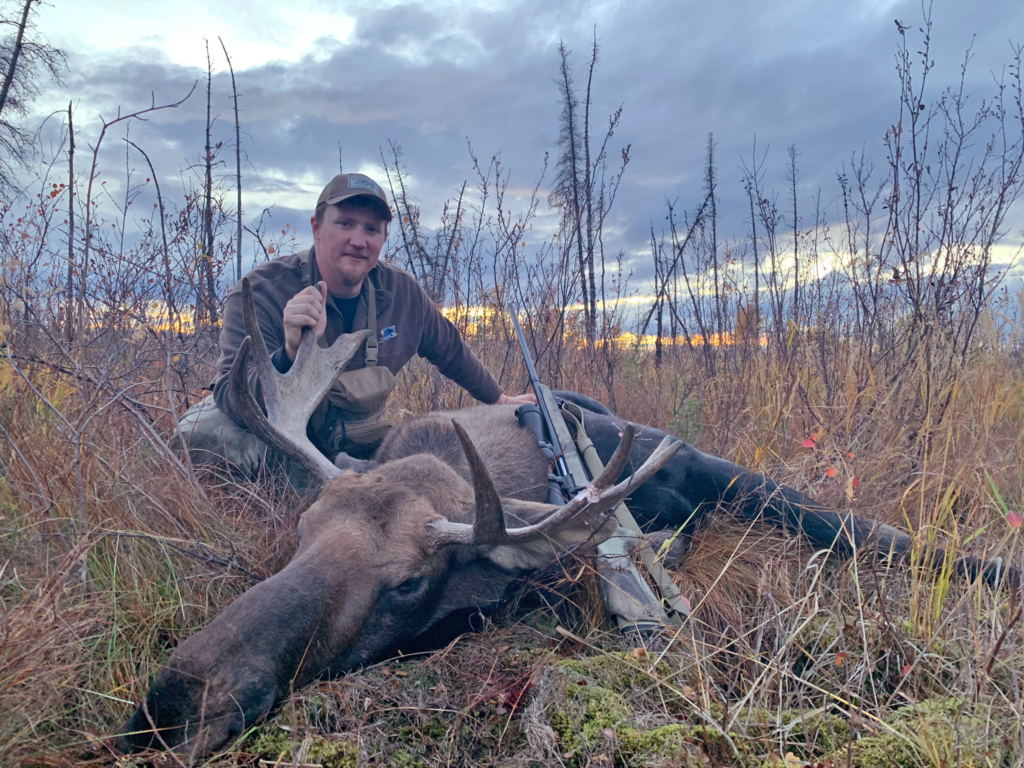
This bull was taken with the 175-grain Sierra bullets in 6.8 Western. Tyler Freel
Just days before my moose hunt, I opened a pre-production box of ammunition as the fumes from the delivery truck still hung in the air. I plucked one of the cartridges out of the box and rolled it around in my hand, looking at the 6.8mm (.270 cal) 175-grain Sierra Tipped Game King bullet. That’ll do, I thought.
This newer Sierra bullet has a G1 B.C. of .617. It’s designed to carry energy at long range, but built to hold together for close shots on big animals. Sierra broke into new .277″ territory with this bullet, as previous chamberings did not have fast enough twist rates to stabilize such a long projectile in that caliber. Their Tipped Game King requires a tighter twist rate—1:8 in the Winchester rifles or 1:7.5 in Browning rifles (lighter .270 bullets are adequately stabilized in a barrel with a 1:10 twist).
I took a quick trip to the local rifle range to zero my gun. I was shooting a Browning X-Bolt Western Hunter, and as usual, I immediately removed the muzzle brake. With my very first shot, I was pleasantly surprised at the mild recoil of the cartridge, even though it was pushing that new 175-grain bullet at a recorded 2835 fps. I zeroed the rifle at 200 yards and the factory loads averaged just under 2-inch, 5-shot groups at that range.
There’s plenty of folks who will argue that any .270 caliber cartridge is too small for moose. They’re wrong. Alaska Yukon moose are big, but they aren’t very difficult to kill. They have big bones and thick hides, but they also have gigantic lungs, and although they usually don’t drop immediately (even with big cartridges), they aren’t indestructible the way some people make them out to be. Now, I should point out that the particular load I was using was definitely more than “just another .270”. With this new 175-grain bullet, at the velocity I measured, from an energy standpoint at the muzzle, it would really sit between a .30-06 and .300 Win. Mag. shooting 180-grain bullets. But the 6.8 Western has a better B.C., and better sectional density than a .308 diameter bullet. I had no doubts in the cartridge, but I was curious about bullet performance, which besides shot placement, is the most critical factor when it comes to putting down big animals.
A couple weeks later, I held the rifle steady atop a tripod as a bull grunted his way through a stand of burnt timber toward my soft cow calls. My buddy and I had been hunting for eight days, we’d passed up several small bulls, and he killed a dandy. I needed meat for the winter, and at this point in the hunt, I didn’t have the luxury of passing another bull. I tracked the moose through my riflescope, only about 100 yards away now, waiting for an opening through the patchwork of charred spruce trees. I moaned out a cow call and the bull stopped, with a hole about the size of a basketball exposing the back of his front shoulder. I shot and the bull spun and took a few steps. I quickly shot again, and then once more. Finally, with only his shoulder exposed, I fired a fourth shot, dropping him. A volley like this might seem excessive or indicative of less-than-lethal performance, but that’s just how moose are, they rarely go down immediately (even when the first shot is lethal). Especially in such tight quarters, its best to keep shooting in case your first shot wasn’t as good as you thought. When we walked up to the bull, I found that my first shot had been perfect, with another a few inches away, also through the lungs. The third shot had hit a branch and ricocheted into the bull’s antler. The fourth shot punched square through the scapula.
I was happy to see that both lung shots were complete pass-throughs. It seemed that the bullets held together well—even at relatively short-range—because I didn’t find any petals or shrapnel in the body cavity. The final shot had completely broken the scapula, but didn’t yield the kind of catastrophic meat damage on the impact side that you’d expect from a bullet coming apart. In fact, I recovered the bullet under the hide on the back side, and it still weighed 102 grains, a weight retention of 58 percent. Considering the range, velocity, and what it impacted through (a bull moose’s shoulder), I was impressed. —T.F.
165-Grain Accubond Long Range in 6.8 Western
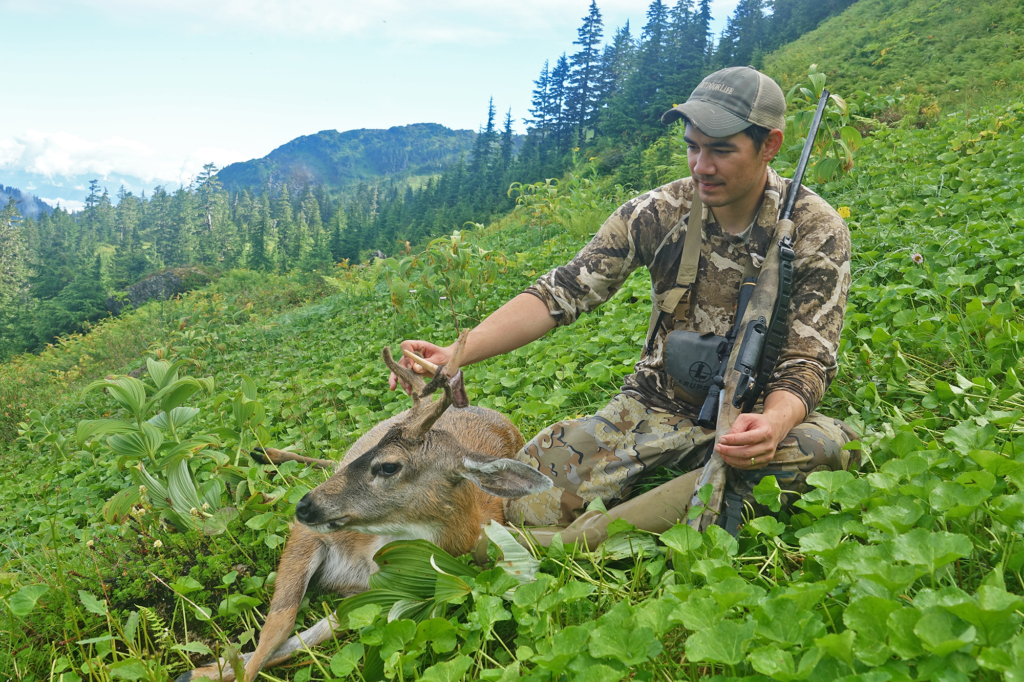
Robinson’s blacktail buck taken with the 165-grain Accubond Long Range bullet in 6.8 Western. Bjorn Dihle
I received my 6.8 Western ammo in nondescript preproduction box last summer, about a month before heading to Alaska for a blacktail deer and mountain goat hunt. And just like Freel, I was shooting a Browning X-Bolt Western Hunter, and mine was topped with a Leupold VX-3i 3.5-10mm scope.
The Accubond Long Ranges are bonded, boattail bullets with polymer tips. As their name implies, they’re designed to expand reliably at long ranges and lower velocities, (down to 1,300 fps.) The 165-grain ABLRs have a muzzle velocity of 2970 fps and a G1 BC of .620. From the bench I was able to average just over 1-inch, 5-shot groups at 100 yards.
On the range the rifle handled and functioned nicely, as you would expect from an X-Bolt, and I felt confident in the rifle and cartridge going into my hunt. From there, I proceeded to put the platform through the wringer.
Southeast Alaska was on pace to set rainfall records by the time I arrived in August. And just a few hours after stepping off a plane in Juneau, I was hiking up through the Tongass forest’s old-growth timber after blacktail deer. By the time we reached the alpine, the rifle and optic were soaked, and they stayed that way for the next several days. My hunting partner Bjorn, an experience southeast Alaska outdoorsman, carried a hefty Ruger .338 Win. Mag.—his go-to rifle in bear country. Half the time he used it as a walking stick in the steep, slick terrain. The X-Bolt weighed right around 7.5 pounds and was much easier to carry in the mountains, though I still used it as a walking stick from time to time and managed to slip and fall just as often as Bjorn.
On the last day of our hunt we finally spotted a blacktail buck on a hillside below us. He was about 200 yards away with a doe, on a steep downhill angle. As I got set up to shoot, the doe slipped into the woods but the buck paused at the treeline, quartering away from us hard, looking toward his doe. It was now or never. My shot took him squarely through the hip and he tumbled into a strip of timber below. Bjorn found him piled up just about 150 yards downhill. The bullet had passed clear through the deer.
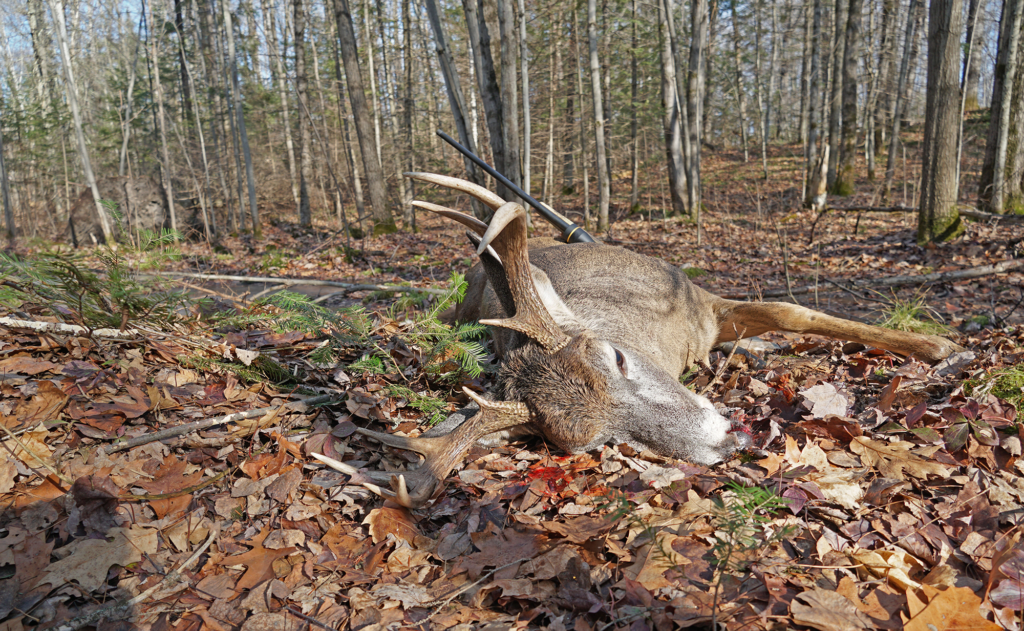
Alex Robinson’s whitetail buck taken with the 165-grain Accubond Long Range bullet in 6.8 Western. Alex Robinson
Later in the fall I took the 6.8 Western to northern Wisconsin for the deer season opener. Just a few hours into opening morning I spotted a nice buck following some does through a stand of thick popple about 90 yards away. He disappeared for a few moments but I could still hear him crunching through the leaves. I spotted a flash of antler and then I gave a loud bleat and the buck stopped in a shooting window for just long enough.
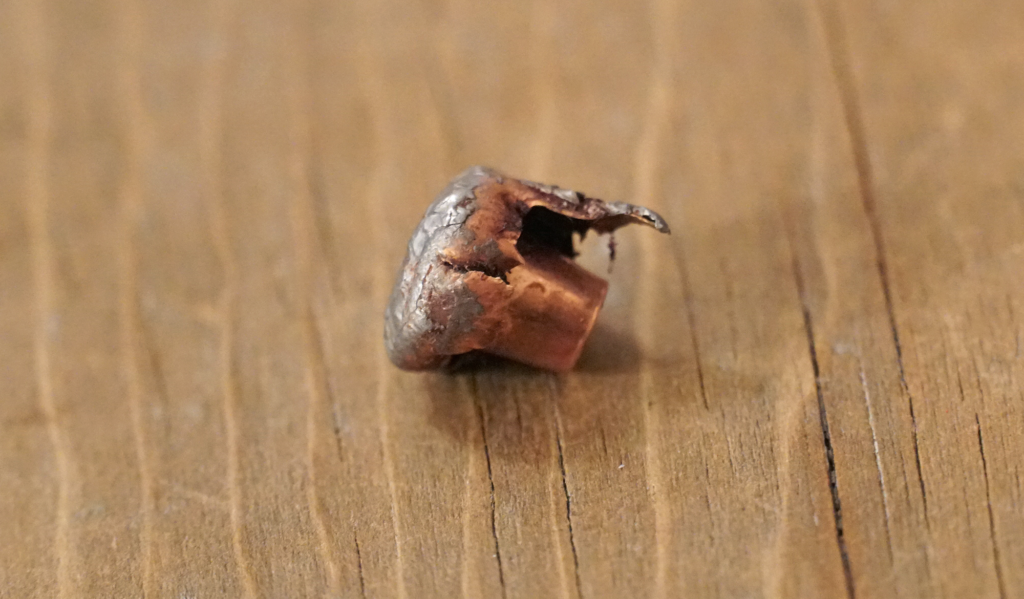
A mushroomed 6.8 Western bullet that was recovered from a whitetail buck. Alex Robinson
At my shot, he bounded about 30 yards and crashed down. The bullet entered behind his front shoulder and buried into the far shoulder. I found it, perfectly mushroomed, just beneath the hide on the offside—excellent performance at medium range. —AR
162-Grain Winchester Copper Impact in 6.8 Western
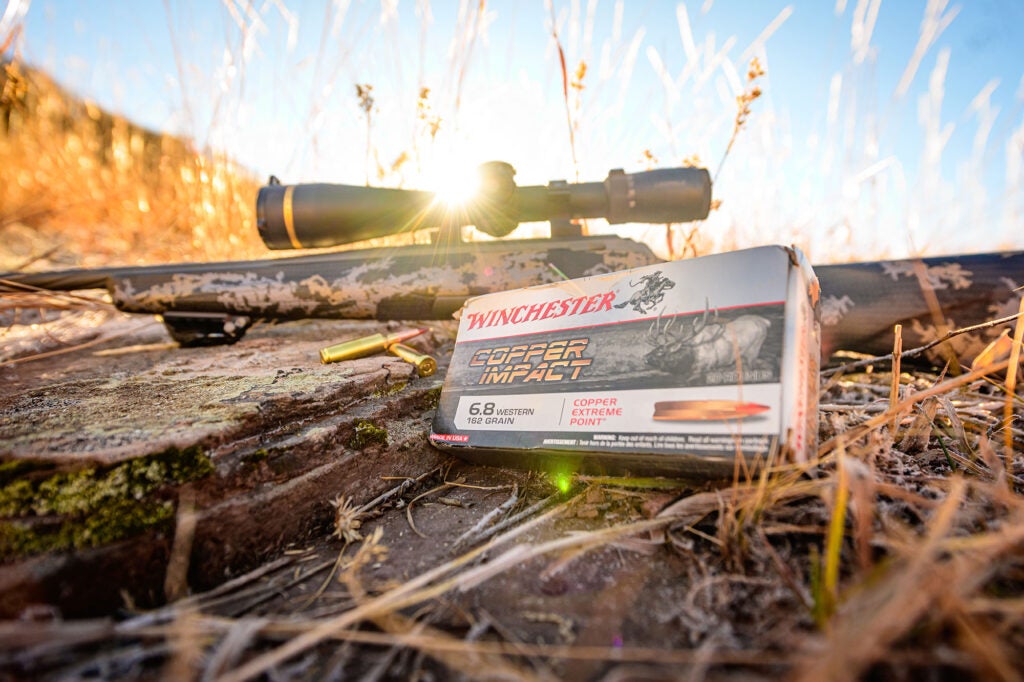
The author’s Browning X-Bolt Mountain Pro and Winchester Copper Impact loads. Tess Rousey
In November 2021 I hunted for elk in Colorado with Browning’s X-Bolt Mountain Pro Long Range rifle loaded with Winchester’s Copper Impact 162-grain loads. The bullet is solid copper, and it designed for what Winchester calls an “oversized impact diameter.” The round as an advertised muzzle velocity of 2875 and a G1 BC (Ballistic Coefficient) of 0.564.
On my hunt in Colorado I shot a nice 5×5 bull inside 100 yards while he was on the move. As he walked through the junipers, I floated my crosshairs over his shoulder and fired. The first shot broke both shoulders and exited. Incredibly, there was minimal meat damage, proving the bullet stayed together as a copper bullet is designed to do. I shot the bull once more, a coup de grâce shot fired from 20 yards. We found that slug while quartering out the bull and surprisingly, it didn’t fully mushroom at such a close range (given the impact velocity), but it did hold together.
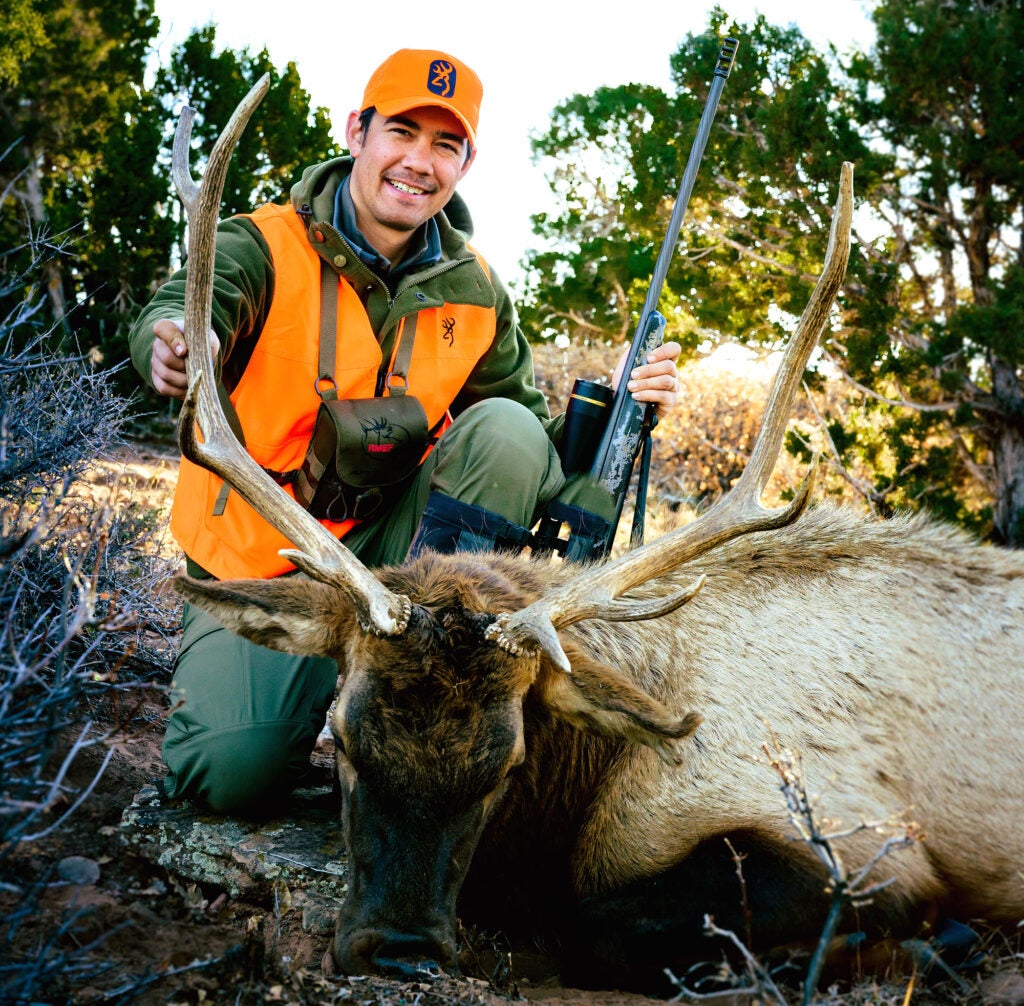
The author with a 5×5 bull taken with the 6.8 Western Copper Impact load. Tess Rousey
As fro the rifle, the X-Bolt Mountain Pro Long Range just might be the best X-Bolt I’ve ever shot. In 6.8 Western with a 26-inch barrel, the rifle weighs 6 pounds 12 ounces. The carbon stock, Cerakote barrel, and crisp trigger bring custom features to a stock rifle. A cushy butt pad and the Recoil Hawg muzzle brake take the bite out the gun. —A.R.
The post 6.8 Western Cartridge Review appeared first on Outdoor Life.
By: Alex Robinson and Tyler Freel
Title: 6.8 Western Cartridge Review
Sourced From: www.outdoorlife.com/guns/6-8-western-cartridge-review/
Published Date: Fri, 18 Nov 2022 19:00:00 +0000
----------------------------------------------
Did you miss our previous article...
https://manstuffnews.com/weekend-warriors/thousands-of-mink-are-causing-mayhem-in-ohio-after-being-sprung-from-a-farm
 Backyard GrillingWeekend WarriorsAdvice from DadBeard GroomingTV Shows for Guys4x4 Off-Road CarsMens FashionSports NewsAncient Archeology World NewsPrivacy PolicyTerms And Conditions
Backyard GrillingWeekend WarriorsAdvice from DadBeard GroomingTV Shows for Guys4x4 Off-Road CarsMens FashionSports NewsAncient Archeology World NewsPrivacy PolicyTerms And Conditions
